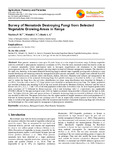Survey of nematode destroying fungi from selected vegetable growing areas in Kenya.

View/
Date
2015-07-02Author
Wachira, PM
Muindi, JN
Okoth SA
Language
enMetadata
Show full item recordAbstract
Plant parasitic nematodes cause up-to 5% yield los
ses to a wide range of economic crops. In Kenya veg
etables
yield loss attributed to plant parasitic nematodes
is estimated to 80%. Over the years, nematode contr
ol has heavily on the use
of chemical nematicides which unfortunately leads t
o biological magnification and elimination of the b
eneficial
microorganisms in the soil. This has triggered a gr
owing interest in search of alternate management st
rategies. The objective of
this study was, therefore, to document nematode des
troying fungi in selected major vegetable growing a
reas in Kenya as a step
towards developing self-sustaining system for manag
ement of plant parasitic nematodes. Soil samples we
re collected from five
vegetable production zones in Kenya which were Kina
re, Kabete, Athi-river, Machakos and Kibwezi and tr
ansported to the
laboratory for extraction of the nematode destroyin
g fungi. Soil sprinkle technique as described by Ja
ffee
et al.,
(1996) was
used to isolate the fungi from the soil while ident
ification was done using identification keys descri
bed by Delgado
et
al.,
(2001). From the study a total of 171 fungi isolate
s were identified as nematode destroying fungi. The
highest population
was recorded at Kabete area recording 33.9% of the
total record, followed by Machakos, Kibwezi, Athi-r
iver and the least in
Kin are with 24.6, 22.2, 11.7 and 7. 6% of the tota
l population in that order.
Arthrobotrys
was the most frequent genera with a
mean occurrence of 7.3 followed by
Monacrosporium
with 6 and
Stylophage
with 5.2.
A.dactyloides
was significantly
(P=0.002) affected by the agro-ecological zones wit
h the highest occurrence being recorded in Kabete a
nd the least in Athi-
river. The highest diversity index and species rich
ness of nematode destroying fungi was recorded in K
ibwezi while the least
was recorded in Athi-river. The genera
Arthrobotrys
had the highest number of trapped nematodes with a
total population of 57,
followed by
Monacrosporium
and least was
Stylopage
with 45 and 36 respectively, within a period of 104
hours. From the
study, it is evident that agricultural practices af
fect the occurrence and diversity of nematode destr
oying fungi and
Arthrobotrys
can be developed as a bio-control agent for managem
ent of plant parasitic nematodes.
URI
http://article.sciencepublishinggroup.com/pdf/10.11648.j.aff.20150404.12.pdfhttp://hdl.handle.net/11295/89944
Citation
Wachira P. M., Muindi J. N., Okoth S. A., Survey of Nematode Destroying Fungi from Selected Vegetable Growing Areas in Kenya, Agriculture, Forestry and Fisheries. Vol. 4, No. 4, 2015, pp. 159-164Publisher
University of Nairobi
